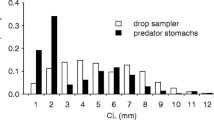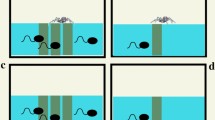Summary
In a previous study (A. Prejs and K. Prejs in press) we found that at the end of the dry season small fish species trapped together with piscivorous fish in small, shallow pool varied in their level of food intake. The two smallest of these species fed little, whereas larger species fed at high rate. By examining the species and size composition of the diet and gape limitations of predatory species, I found that the decreased feeding rate of small fish was in response to a high risk of predation by gape-limited predators. The reduction of feeding rate was very substantial when compared to that of the same species in predator free area.
Similar content being viewed by others
References
Alexander R McN (1967) Functional design in fishes. Hutchinson University Library, London, p 160
Dill LM, Fraser AHG (1984) Risk of predation and the feeding behavior of juvenile coho salmon Oncorhynchus kisutch. behav Ecol Sociobiol 16:65–71
Ewert JP (1974) The neural basis of visually guided behavior. Sci Am 230:32–42
Kislalioglu M, Gibson RN (1976) Some factors governing prey selection by the 15-spined stickleback, Spinachia spinachia L. J Exp Mar Biol Ecol 25:15–169
Knöppel HA (1970) Food of Central Amazonian fishes. Contribution to the nutrient-ecology of Amazonian rain-forest-streams. Amazoniana 2:257–352
Lowe-McConnell RH (1964) The fishes of the Rupununi savanna district of British Guiana, South America. Part 1. Ecological groupings of fish species and effects of the seasonal cycle on the fish. J Linn Soc Lond Zool 45:103–144
Maiorana VC (1976) Predation, submergent behavior, and tropical diversity. Evol Theory 1:157–177
Mittelbach GG (1981) Foraging efficiency and body size: a study of optimal diet and habitat use by bluegills. Ecology 62:1370–1386
Prejs A, Prejs K (1987) Feeding of tropical freshwater fishes: seasonality in resource availability and resource use. Oecologia (Berlin) (in press)
Rodriguez AJ (1980) Alimentacion de los “cuchillos” Eigenmannia virescens y Gymnotus carapo en el Modulo Experimental del Mantecal Edo Apure. Dissertation, Universidad Central de Venezuela, Caracas, Venezuela, p 111
Schmitt RJ, Holbrook SJ (1984) Gape-limitation, foraging tactics and prey size selectivity of two microcarnivorous species of fish. Oecologia (Berlin) 63:6–12
Scott MA, Murdoch WW (1983) Selective predation by the backswimmer, Notonecta. Limnol Oceanogr 28:352–366
Sih A (1982) Foraging strategies and avoidance of predation by an aquatic insect predator Notonecta hoffmani. Ecology 63:786–796
Smith SM (1976) Predatory behaviour of young torqouise-browed Motmots, Eumomota supreciliosa. Behaviour 56:309–320
Soares MG (1979) Aspectos ecologicos (alimentacao e reproducao) dos peixes do igarape do Porto, Aripuana, MT. Acta Amazonica 9:325–352
Stein RA (1977) Selective predation, optimal foraging and the predator-prey interaction between fish and crayfish. Ecology 63:786–796
Stein RA (1979) Behavioral response of prey to fish predators. In: Stroud RH, Clepper H (eds) Predator-prey systems in fisheries management. Sport Fishing Institute, Washington DC, p 504
Ware DM (1973) Risk of epibenthic prey to predation by rainbow trout Salmo gairdneri. J Fish Res Board Can 30:787–797
Werner EE, Hall DJ, Laughlin DR, Wagner DJ, Wilsmann LA, Funk FC (1977) Habitat partitioning in a freshwater community. J Fish Res Board Can 34:360–370
Werner EE, Gilliam JF, Hall DJ, Mittelbach GG (1983) An experimental test of the effects of predation risk on habitat use in fish. Ecology 64:1540–1548
Zaret TM (1980) Predation and freshwater communities. New Haven, Yale Univ Press, p 187
Author information
Authors and Affiliations
Rights and permissions
About this article
Cite this article
Prejs, A. Risk of predation and feeding rate in tropical freshwater fishes: field evidence. Oecologia 72, 259–262 (1987). https://doi.org/10.1007/BF00379276
Received:
Issue Date:
DOI: https://doi.org/10.1007/BF00379276




